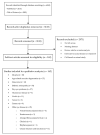Vitamin D and Ocular Diseases: A Systematic Review
- PMID: 35457041
- PMCID: PMC9032397
- DOI: 10.3390/ijms23084226
Vitamin D and Ocular Diseases: A Systematic Review
Abstract
The contributory roles of vitamin D in ocular and visual health have long been discussed, with numerous studies pointing to the adverse effects of vitamin D deficiency. In this paper, we provide a systematic review of recent findings on the association between vitamin D and different ocular diseases, including myopia, age-related macular degeneration (AMD), glaucoma, diabetic retinopathy (DR), dry eye syndrome (DES), thyroid eye disease (TED), uveitis, retinoblastoma (RB), cataract, and others, from epidemiological, clinical and basic studies, and briefly discuss vitamin D metabolism in the eye. We searched two research databases for articles examining the association between vitamin D deficiency and different ocular diseases. One hundred and sixty-two studies were found. There is evidence on the association between vitamin D and myopia, AMD, DR, and DES. Overall, 17 out of 27 studies reported an association between vitamin D and AMD, while 48 out of 54 studies reported that vitamin D was associated with DR, and 25 out of 27 studies reported an association between vitamin D and DES. However, the available evidence for the association with other ocular diseases, such as glaucoma, TED, and RB, remains limited.
Keywords: age-related macular degeneration; dry eye syndrome; glaucoma; myopia; ocular disease; retinoblastoma; thyroid eye disease; uveitis; vitamin D; vitamin D receptor.
Conflict of interest statement
The authors declare no conflict of interest.
Figures


References
Publication types
MeSH terms
Substances
LinkOut - more resources
Full Text Sources
Medical

